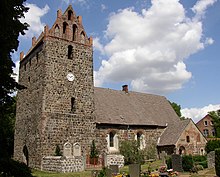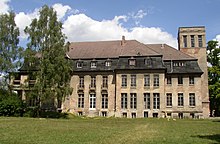Börnicke (Bernau near Berlin)
|
Börnicke
City of Bernau near Berlin
Coordinates: 52 ° 39 ′ 46 ″ N , 13 ° 38 ′ 16 ″ E
|
|
|---|---|
| Height : | 83 m |
| Area : | 13.27 km² |
| Residents : | 501 (December 31, 2014) |
| Population density : | 38 inhabitants / km² |
| Incorporation : | December 31, 2002 |
| Postal code : | 16321 |
| Area code : | 03338 |
Börnicke has been part of the city of Bernau near Berlin since December 31, 2002 . Around 500 people live in the village southeast of the city of Bernau on Landesstrasse 30 in the Barnimer Feldmark.
history
The anger village "Borneke" was first mentioned in a document from 1300, in which the Friedland monastery near Wriezen was confirmed to have its goods in the march . The Cistercian convent probably had properties in Börnicke until the middle of the 15th century.
From the end of the 15th century until the second half of the 17th century, the village was owned by the von Arnims who lived in Biesenthal . It developed into an estate village. The village was badly damaged in the Thirty Years War and was desolate afterwards. In 1679 Wolmir von Wrangel , commander of the Electoral Life Guard in Berlin, acquired the estate and began to re-occupy the Hüfner and Kossaten posts. As a patron of the church , he had the images of the apostles still preserved on the choir stalls ; the rest of the furnishings date from 1883.
Village church
Parts of the village church, which is one of the most important buildings of the place, have been preserved from the time of the first documentary mention. The village church in Börnicke is a hall church made of field stone masonry, which was built in the second half of the 13th century and later vaulted. There you will find, among other things, a painted elderly chair from 1679, which is rare in the region, and the tombstones of a banker couple from the Mendelssohn family from 1909.
additional
Von Wrangel arranged for the children to be taught in a half-timbered house (today's Dorfstrasse 3) on the Anger , in front of which the judicial linden tree still stands today. In the 18th and 19th centuries, the ownership changed frequently, and the village population had to adjust to new landowners again and again, including the von Barfus family , the Schindler Secret Council (founder of the Schindler orphanages in Berlin), the economic councilor Albrecht Philipp Thaer and Otto Franz Theodor Hosemann.
In 1892 the co-owner of the Berlin banking house Mendelssohn & Co., the Kommerzienrat Ernst Mendelssohn-Bartholdy , great-grandson of the philosopher Moses Mendelssohn and nephew of the composer Felix Mendelssohn Bartholdy , acquired the Börnicke estate. In 1896 the family was ennobled . From 1909, his son Paul Robert Ernst von Mendelssohn-Bartholdy had the Börnicke Palace rebuilt and the park designed by the architect Bruno Paul . The family grave of the von Mendelssohn-Bartholdy family is at the church tower.
The manor house was built in the middle of the 19th century in the classical style. Together with the horse stable, which is also part of the estate, it was restored by the city of Bernau in 2006–2009 in accordance with the protection of historical monuments.
In the course of the land reform after 1945, numerous new farmhouses were built. An agricultural production cooperative (LPG) and the people's own estate (VEG) determined economic life in the village until the fall of the Berlin Wall .
The castle was used in different ways. Between 1967 and 1992 it served as a kindergarten, school and boarding school for handicapped children. After 1992 the building was empty before it became private property in 2003. In the past few years, the partially dilapidated building was made accessible again and opened for the first cultural events.
The village and its surroundings
Börnicke lies on a wavy surface, shaped by the Ice Age, in which numerous pools are embedded. Just like the avenues and trees that characterize the landscape, these play an important role as living and retreat areas for various animal and plant species. The majority of the area surrounding the village is agricultural land and is mainly cultivated by the Albertshof and Birkholz estates. Traditionally, sheep breeding still plays an important role today .
Börnicke is a member of the Barnimer Feldmark Regional Park . Various cycling and hiking trails lead from Bernau to Börnicke and the Barnimer Feldmark.
In the immediate vicinity of the village are two former Vorwerke of the Börnicke estate, Helenenau and Thaerfelde .
The Vorwerk Thaerfelde , located northeast of the village, was built between 1840 and 1842 by the State Economist Albrecht Philipp Thaer. Sheep breeding was primarily pursued here. Thaer was the son of the founder of agricultural science Albrecht Daniel Thaer and was also called "Wollthaer" because of his great interest in sheep breeding.
The Vorwerk Helenenau , built about two kilometers southwest of the village, was named after the wife and daughter of the former landowner Otto Franz Theodor Hosemann. Hosemann had received the estate in 1861 from his father-in-law Simon in Malchow as a wedding present. Henriette Helene Wilhelmine and daughter Helene Auguste died in childbed in a Berlin clinic in 1871. Today the former Vorwerk offers a range of leisure activities, with equestrian sports playing an important role.
The village of Börnicke itself lies in a depression, which meant that the landscape park belonging to the castle could only be created when the oak bush pond in its center was drained in the direction of Bernau towards the Panke in 1871 . Winding paths in the park now lead around the pond and repeatedly open up new views of the vast expanse of water and an island within it. A small children's zoo (children's farm) was set up in the western part of the park, in which various pets are shown. In the immediate vicinity of the castle, geometric beds and lawns dominate.
The Angerdorf is characterized by its village pond, which often becomes the center of cultural life in the village. The regular events in the village and on the estate include the stork festival, the farmers' market and the Advent market. The oldtimer meeting and the open air concerts of the Börnick Music Summer should also be mentioned. Several craftsmen and artists have found a home on the estate, who enrich the cultural offerings of the place with their own contributions. The Förderverein Schloss und Gutshof Börnicke eV was founded in 2003, which endeavors to provide a varied program of events and sensible usage concepts for the castle, estate and park Börnicke.
Architectural monuments
In the village area of the Börnicke district there are some architectural monuments : the residential building at Dorfstrasse 5, the farm workers' house at Dorfstrasse 20, the village church and the estate complex consisting of two four-sided courtyards of different sizes with the manor house and various farm buildings , stables, barns and a former schnapps distillery .
politics
The local advisory board includes Matthias Jitschin, Wolfgang Kirsch and Heiko Jesse. Matthias Jitschin has been the mayor since May 2014. Deputy mayor is Wolfgang Kirsch.
Infrastructure
Börnicke is connected to Bernau near Berlin and Werneuchen by lines 908 of the Barnimer Busgesellschaft as part of the public transport system.
societies
Associations in Börnicke include:
- Friends of Castle and Gutshof Börnicke e. V.
- KulturGut e. V. Börnicke
- Riding and Driving Association Helenenau e. V.
literature
- Elke Blauert: Börnicke. In: Palaces and Gardens of the Mark, No. 61, Berlin 2004.
- City of Bernau near Berlin (Ed.): Börnicke - Discover Börnicke , August 2013
Web links
- City portrait: Börnicke near the city of Bernau near Berlin
- Börnicke ( Memento from October 21, 2013 in the Internet Archive ) at the Barnim district with information on the village church
- Börnicke at the Barnimer Feldmark Regional Park
Individual evidence
- ↑ Börnicke on the Barnim website ( Memento from October 21, 2013 in the Internet Archive ).
- ^ Ernst Badstübner: Brandenburg. Between the Elbe and the Oder - art and history of the north German interior. Dumont Art Guide, 3rd edition, DuMont Buchverlag, Cologne 1995, ISBN 3-7701-2579-7 , p. 216.
- ↑ Kulturgut Börnicke, accessed July 2012 ( page no longer available , search in web archives ).
- ^ City of Bernau near Berlin (Ed.): Börnicke. Flyer from the Tourist Office, PUBLIC Agency for Communication, Bernau, undated
- ^ Society for the Research and Promotion of the Märkische Eiszeitstraße e. V. (Ed.): Along the Märkische Eiszeitstraße. A journey through the Barnimer Land and the Uckermark. Eberswalde 1995, p. 20.



